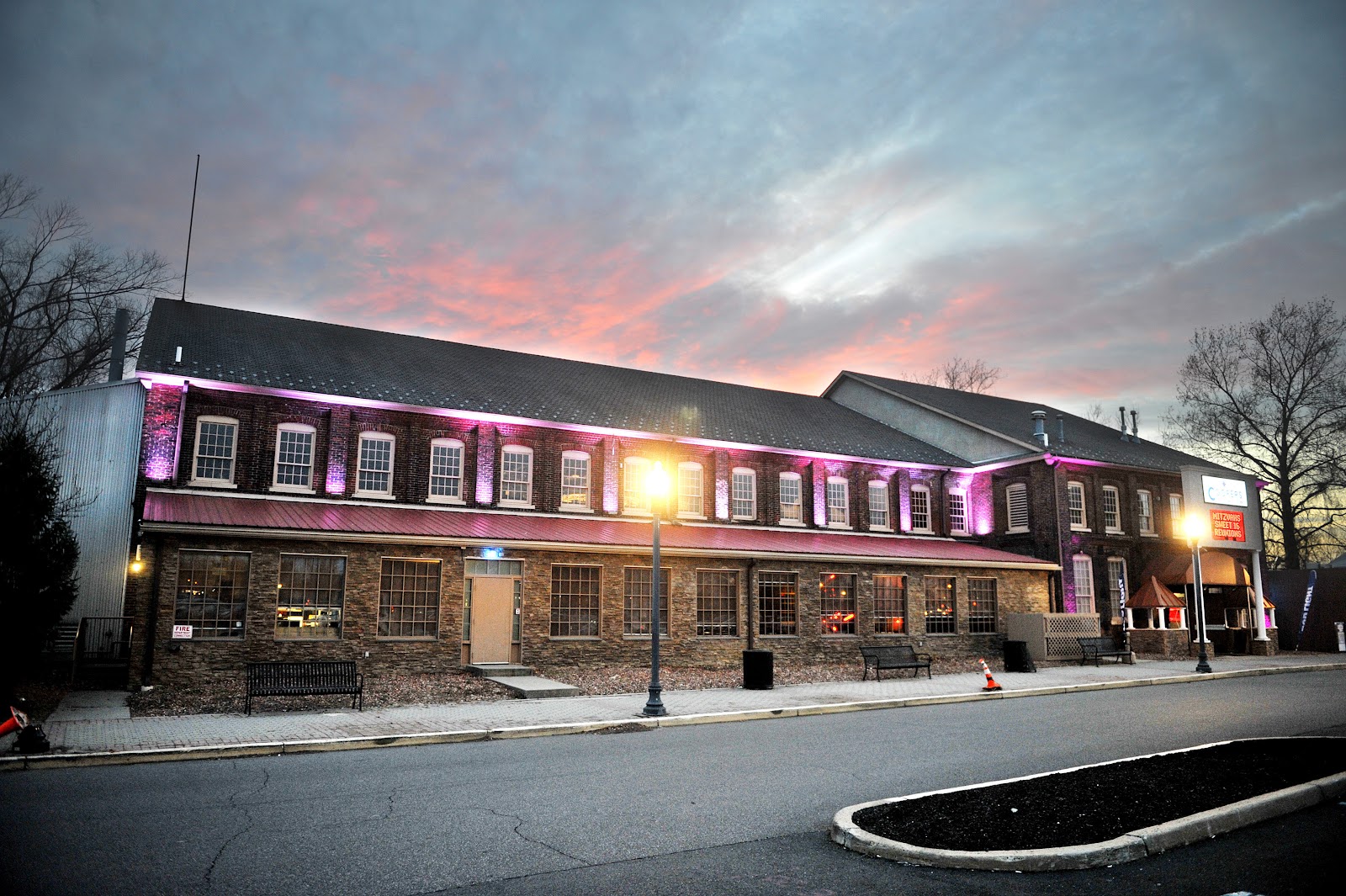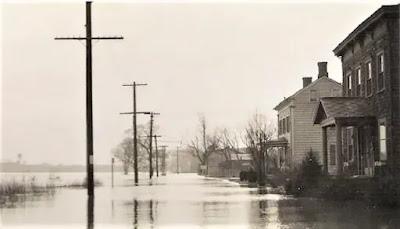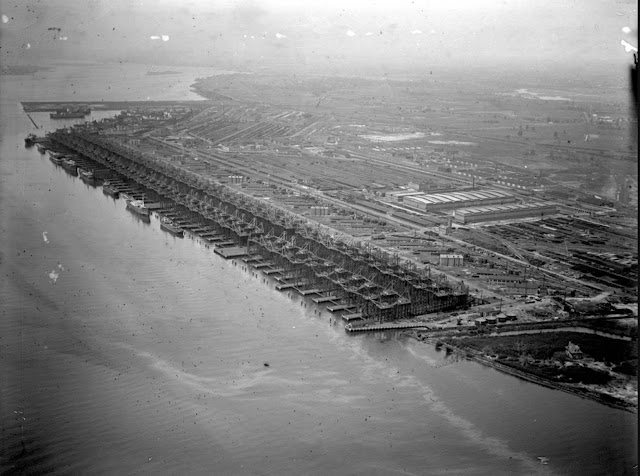Click on to enlarge
With the brutal weather continuing it was a good day to stay inside and get some work done before freshman orientation next week and the start of the fall semester. Of course my undiagnosed ADHD kicked in and I wandered off into fishing, Trenton, and some local history of the Delaware River. I'm not well versed in history but I do enjoy it. I'm not good with dates and events but I really like looking at the history of cities and their changing landscapes over the years. While Newark is my favorite city of all time, living down near Trenton has become a solid second. Not only did the Delaware River play a huge part on the history of industrialization and manufacturing in the city it also was a huge part in the fisheries and fishing from the days of the Indians until today. Those fish included American shad, alewife and blueback herring, sturgeon and striped bass. But I'll do fish and fishing another time.

The landscape of the riverfront in Trenton and across the river in Morrisville, Pa. has changed dramatically in the last 100 years. What lead me to this post was an image of the old American Bridge Steel Factory that sat where the Trenton Thunder baseball stadium now sits. Those factories changed
names over the years and the last remaining part is now occupied by the restaurant Cooper's Riverview, which was previously Kat Man Du. Just north of Cooper's the old wharf has been dismantled to make
way for a new waterfront park which is planned to connect Lamberton Street to The Island neighborhood opposite Rotary and Blaugard Islands in the cities most northern section along the river. Then there are the bridges, which haven't changed much as of late. Starting from the south there is the
Morrisville-Trenton Railroad Bridge, the Trenton-Morrisville (US.1 ) Toll Bridge, the Lower Trenton Bridge or 'Trenton Makes Bridge", and to the north the Calhoun Street Bridge.
One of the biggest changes to Trenton's waterfront occurred in the 1950's when the John Fitch Highway, or Route 29, was constructed which cut through the waterfront neighborhoods separating, if you will, the city from the waterfront. Some say it was the worst planned highway built in the U.S. To construct the highway the city used Eminent Domain to seize homes, apartment buildings, and commercial buildings to make way for the construction of the 9 mile highway. Also destroyed was the once grand Stacy Park, which sat between the State House and the Delaware River. Interestingly just
in front of the Capital building was a canal called Trenton Water Power which supplied the cities drinking water. There were a series of pedestrian bridges which went from State House building side
over to Stacy Park. From the 1940's until it's final end in the mid-1960's Stacy Park's size diminished. Parts of it were taken to make way for buildings and parking lots and the final parcels taken for the
completion of Route 29 below the Calhoun Street Bride down to Lalor Street. Later, in the early 2000's the Trenton Tunnel was constructed and on top of it the six-acre River Walk Park now sits .
Across the river is Morrisville, Pennsylvania and that side of the river has seen major changes in the last 100 years as well. Starting just south of the Calhoun Street Bridge, in front of the Morrisville Water Works, are the remnants of the old wing dam. Looking below you can see it with the levee in the
foreground. The wing dam created a diversion, or channel, on the Morrisville side around where Morrisville Island once stood. You can see more of the wing dam in a section of the map below. You can clearly
see the channel that sits between the mainland of Morrisville and Morrisville Island. (I can't imagine how good the fishing was off of that wing dam back in the day.) That all changed during the Great Flood of 1936 when the Delaware River crested some 25 feet flooding the Island and into Morrisville's and Trenton's downtown. On Morrisville Island the street that faced the river was, and still is, Delmorr Avenue. Today the landscape of that neighborhood is very different.
After that flood a levee was built along the river and the channel cut off and filled in to for what is now Williamson Park. There is no more Morrisville Island. If you go there today you can visualize where the river cut through and where is would have emptied just in the shadows of the Trenton - Morrisville Bridge on the Morrisville side.

Below the bridges on the Pennsy side there wasn't much directly on the river. That's until you hit where the massive U.S. Steel Fairless Works plant sat on the Delaware River until it was shuttered and
demolished around 2010. Currently from the area south of the Morrisville-Trenton Railroad Bridge on the Pa. side to where U.S. Steel once sat is a series of large warehouse complexes, some sitting almost on the river and around Biles Creek which enters and exits in Falls Township, Pa. And to come full
circle it's only right to jump back across the river and to Duck Island which sits in and around Lamberton Street. It was there where the PSEG Mercer Generating Station once operated and stood. It was a massive coal fired plant, one of three in New Jersey, which was shut down in 2017 and demolished in 2020. And heading north on Duck Island before
you hit Route 29 and the Trenton Tunnel you'll pass what's left of the Trenton Marine Terminal. Since Trenton was an industrial powerhouse city located on the Delaware River transportation and shipping
were a major part of the waterfront. Depths of the river, and its nine foot tides, made Trenton the most northern destination for large ships. Not only did it become shallow around the Trenton Falls but the Trenton Makes Bridge and its piers made navigating the channels impossible. Ships could go as far as the train bridge, and before the wharf was demolished in 2023 you could see remnants of it (below).
If you go to the Trenton Marine Terminal today you can see what's left of two large cranes that once stood there. The cranes, interestingly called the Hog Island Cranes, and not the Duck Island Cranes
which is on the ground where they stood, are on the National Site of Historic Places. The two gantry cranes played an important role in shipbuilding during World War I. They were originally located on Hog Island, at the Hog Island Shipyard, two of 28 cranes that stood on the banks of the Delaware River
in Philadelphia. In 1930 the cranes were sold off as government surplus and sold to Trenton for $5,000 each for Trenton. The intent was to increase Trenton as a working seaport. What is noted in the National
Parks service nomination form from 1980 is that "...Trenton is planning to refurbish and maintain the cranes in their current environment." For years the cranes were put to work and could be seen along the
river and from points north looking south down the river. I did lots of digging online and couldn't find any information on what happened to those cranes. I did find out that in 2003 an ice dam and river
flows caused part of the terminal to collapse. Maybe it was then the cranes were dismantled and most likely sold for scrap. As with everything else the heydays of the Trenton and Morrisville waterfronts are far in the past. The TMT was once a bustling terminal for passenger and industrial ships to call it a stop.
The story above is similar to so many other cities that have seen things change and not for the better. Can you imagine getting all gussied up to take a boat ride up to Trenton where you would visit the bustling downtown or visit your Italian family in the city's Chambersburg neighborhood. Or maybe
catch a ride over to the Pennsylvania Rail Road Station for a trip to New York City. I tell you, without being there, those times were much better. Back in the day our ancestors survived two World Wars, the Great Depression, and tons of other problems, like discrimination and unrest, and seemed to have found a way to survive and provide. The landscapes were different, the quality of things was different, and we were different. It wasn't perfect I am sure, but I'd would really have loved to have been around from say the 1930's going forward. Alright, time to get back to work.



























